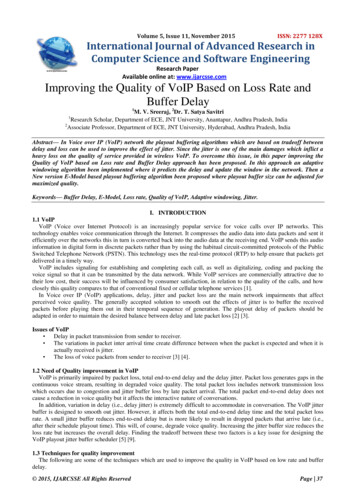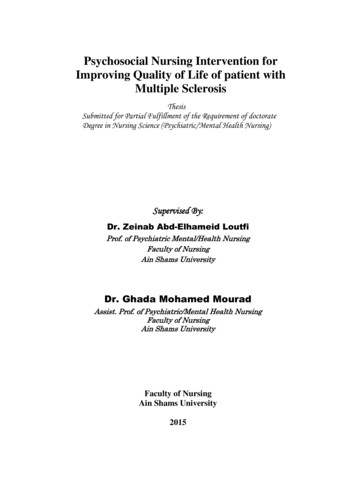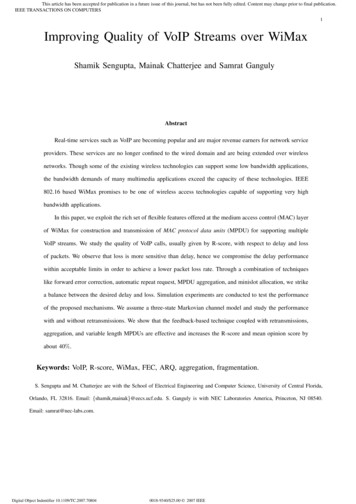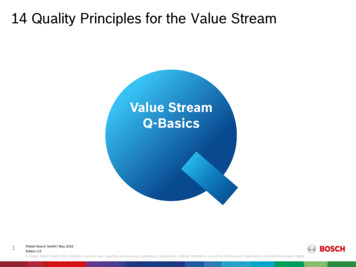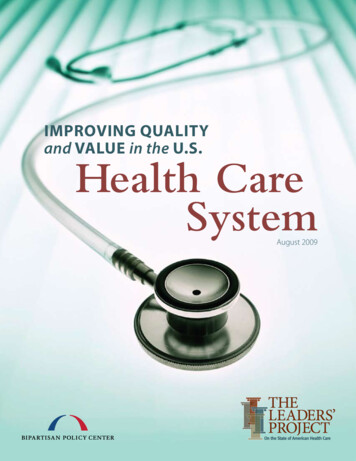
Transcription
improving Qualityand Value in the U.S.Health CareSystemAugust 2009
PreambleThe Bipartisan Policy Center (BPC) is a public policy advocacy organization founded by former U.S.Senate Majority Leaders Howard Baker, Tom Daschle, Bob Dole, and George Mitchell. Its missionis to develop and promote solutions that can attract the public support and political momentumto achieve real progress. The BPC acts as an incubator for policy efforts that engage top politicalfigures, advocates, academics, and business leaders in the art of principled compromise.This report is part of a series commissioned by the BPC to advance the substantive work of theLeaders’ Project on the State of American Health Care. It is intended to explore policy trade-offs andanalyze the major decisions involved in improving health care delivery, and discuss them in thebroader context of health reform. It does not necessarily reflect the views or opinions of SenatorsBaker, Daschle, and Dole or the BPC’s Board of Directors.The Leaders’ Project was launched in March 2008. Co-Directed by Mark B. McClellan and ChrisJennings, its mission is (1) to create a bipartisan plan for health reform that can be used totransform the U.S. health care system, and (2) to demonstrate that health reform is an achievablepolitical reality. Over the course of the project, Senators Baker, Daschle, and Dole hosted publicpolicy forums across the country, and orchestrated a targeted outreach campaign to Members ofCongress, the Administration, and key health care constituencies. In June 2009, they released theProject’s final report entitled, Crossing Our Lines: Working Together to Reform the U.S. Health System,which includes a slate of comprehensive policy recommendations to address the delivery, cost,coverage, and financing challenges facing the nation’s health system. For more information, pleasevisit www.bipartisanpolicy.orgThe BPC is honored to have the support of the Robert Wood Johnson Foundation (RWJF).RWJF is working to ensure that all Americans have stable, affordable health care coverage.For more information on the Bipartisan Policy Center, please visit its website atwww.bipartisanpolicy.org.
improving Qualityand Value in the U.S.Health CareSystemAugust 2009
AuthorsImproving Quality and Value in the U.S. Health Care System was written by teams at theEngelberg Center for Health Reform at the Brookings Institution and by Avalere Health, LLC.Engelberg Center for Health Reform, Brookings InstitutionAaron McKethan, Ph.D., Research DirectorMark Shepard, Research AssistantS. Lawrence Kocot, M.P.A., J.D., LL.M., Engelberg Center Deputy Director and Senior CounselNiall Brennan, M.P.P., Senior Research AssociateMarisa Morrison, Senior Research AssistantNadia Nguyen, Senior Research AssistantAvalere Health LLCReginald D. Williams II, Senior ManagerNicole Cafarella, Senior AssociateAcknowledgementsThe authors gratefully acknowledge the following individuals:Katherine HayesKristina LowellAdam AtenDavid Brogan
Table of ContentsExecutive Summary . . . . . . . . . . . . . . . . . . . . . . . . . . . . . . . . . . . . . . . . . . . . . . . . . . . . . . . . . . . . . . . . . . . . . . . . . . . . . . . . . . . . . . . . . .iIntroduction . . . . . . . . . . . . . . . . . . . . . . . . . . . . . . . . . . . . . . . . . . . . . . . . . . . . . . . . . . . . . . . . . . . . . . . . . . . . . . . . . . . . . . . . . . . . . . . . . .1The Need to Improve Quality and Increase Value in the U.S. Health System . . . . . . . . . . . . . . . . . . . . . . . . . . . . . . .3Health Care Delivery Reforms . . . . . . . . . . . . . . . . . . . . . . . . . . . . . . . . . . . . . . . . . . . . . . . . . . . . . . . . . . . . . . . . . . . . . . . . . . . . . . . .9Managing Chronic Disease . . . . . . . . . . . . . . . . . . . . . . . . . . . . . . . . . . . . . . . . . . . . . . . . . . . . . . . . . . . . . . . . . . . . . . . . . . . . . . . .9Improving the Coordination of Care . . . . . . . . . . . . . . . . . . . . . . . . . . . . . . . . . . . . . . . . . . . . . . . . . . . . . . . . . . . . . . . . . . . . . . . 14Investing In Health Information Technology . . . . . . . . . . . . . . . . . . . . . . . . . . . . . . . . . . . . . . . . . . . . . . . . . . . . . . . . . . . . . . . 19Integrated Delivery Reforms . . . . . . . . . . . . . . . . . . . . . . . . . . . . . . . . . . . . . . . . . . . . . . . . . . . . . . . . . . . . . . . . . . . . . . . . . . . . . . . 22Developing Value-Based Consumer Incentives . . . . . . . . . . . . . . . . . . . . . . . . . . . . . . . . . . . . . . . . . . . . . . . . . . . . . . . . . . . . . 25Realigning Reimbursement to Health Care Providers . . . . . . . . . . . . . . . . . . . . . . . . . . . . . . . . . . . . . . . . . . . . . . . . . . . . . . . 28Investing In Better Evidence on What Works . . . . . . . . . . . . . . . . . . . . . . . . . . . . . . . . . . . . . . . . . . . . . . . . . . . . . . . . . . . . . . . 36Modeling the Coverage Implications of Cost Savings . . . . . . . . . . . . . . . . . . . . . . . . . . . . . . . . . . . . . . . . . . . . . . . . . . . . . . . 41Conclusion and Recommendations . . . . . . . . . . . . . . . . . . . . . . . . . . . . . . . . . . . . . . . . . . . . . . . . . . . . . . . . . . . . . . . . . . . . . . . . . . 45References . . . . . . . . . . . . . . . . . . . . . . . . . . . . . . . . . . . . . . . . . . . . . . . . . . . . . . . . . . . . . . . . . . . . . . . . . . . . . . . . . . . . . . . . . . . . . . . . . . . . 52
Crossing Our Lines: Working Togetherto Reform the U.S. Health SystemCrossing Our Lines is a bipartisan agreement forcomprehensive health reform reached by SenatorsHoward Baker, Tom Daschle, and Bob Dole. It is theculmination of an inclusive year-and-a-half effortthat included strategic outreach to key health carestakeholders, a series of state-based public policyforums, and months of personal deliberations bythe Senators. Taken together, the recommendations ensure that allAmericans have quality, affordable health coverage, while improving healthcare quality and reining in skyrocketing costs. Organized around four “pillars” ofhealth reform, the policies are inextricably intertwined, and consequently worktogether to achieve more significant improvements in the health care systemthan could be achieved if they were considered in an isolated manner.i. Promoting High-Quality, High-Value CareiI. Making Health Insurance Available, Meaningful and AffordableiII. Emphasizing and Supporting Personal Responsibility andHealthy ChoicesiV. Developing a Workable and Sustainable Approach toHealth Care FinancingTo download a copy of the key recommendations or the full report, please visitwww.bipartisanpolicy.org.
iExecutive SummaryThe U.S. health care system faces significantchallenges that clearly indicate the urgent needfor reform. Attention has rightly focused on theapproximately 46 million Americans who areuninsured, and on the many insured Americans whoface rapid increases in premiums and out-of-pocketcosts. As Congress and the Obama Administrationconsider ways to invest new funds to reduce thenumber of Americans without insurance coverage,we must simultaneously address shortfalls in thequality and efficiency of care that lead to higher costsand to poor health outcomes. To do otherwise castsdoubt on the feasibility and sustainability of coverageexpansions and also ensures that our current healthcare system will continue to have large gaps — evenfor those with access to insurance coverage.There is broad evidence that Americans often donot get the care they need even though the UnitedStates spends more money per person on healthcare than any other nation in the world. Preventivecare is underutilized, resulting in higher spending oncomplex, advanced diseases. Patients with chronicdiseases such as hypertension, heart disease, anddiabetes all too often do not receive proven andeffective treatments such as drug therapies or selfmanagement services to help them more effectivelymanage their conditions. This is true for insured,uninsured, and under-insured Americans. Theseproblems are exacerbated by a lack of coordinationof care for patients with chronic diseases. Theunderlying fragmentation of the health care system isnot surprising given that health care providers do nothave the payment support or other tools they needto communicate and work together effectively toimprove patient care.While many patients often do not receive medicallynecessary care, others receive care that maybe unnecessary, or even harmful. Research hasdocumented tremendous variation in hospitalinpatient lengths of stay, visits to specialists,procedures and testing, and costs — not only bydifferent geographic areas of the United States, butalso from hospital to hospital in the same town. Thisvariation has no apparent impact on the health ofthe populations being treated. Limited evidence onwhich treatments and procedures are most effective,limited evidence on how to inform providers aboutthe effectiveness of different treatments, and failuresto detect and reduce errors further contribute togaps in the quality and efficiency of care. These issuesare particularly relevant to lower-income Americansand to members of diverse ethnic and demographicgroups who often face great disparities in health andhealth care.
iiimproving quality and value in the u.S. Health Care systemReforming our health care delivery system to improvethe quality and value of care is essential to addressescalating costs, poor quality, and increasing numbersof Americans without health insurance coverage.Reforms should improve access to the right care atthe right time in the right setting. They should keeppeople healthy and prevent common, avoidablecomplications of illnesses to the greatest extentpossible. Thoughtfully constructed reforms wouldsupport greater access to health-improving care — incontrast to the current system, which encouragesmore tests, procedures, and treatments that are atbest unnecessary and at worst harmful.This report reviews the evidence on a range of paymentand delivery system reforms designed to improvequality and value. It reaches several conclusions:1. While there is ongoing debate about the abilityof various delivery system reforms to increasevalue, there are clear attributes of differentapproaches to reform that are more likely thanothers to improve health and slow cost growth.Chronic Disease Management, Primary CareCoordination, and Health Information Technology(HIT) — There is strong evidence that particularapproaches or programs in these areas can improvequality and health outcomes. Some interventionsalso show evidence of lowering total cost growth.At the same time, these reforms, as implemented,have been very heterogeneous, and improvementsin value and especially reductions in cost have notbeen automatic. While we find promising evidencethat delivery system interventions can help slowthe growth of health care costs, we argue that itshould be possible to achieve larger and morecertain savings by having meaningful risk-adjustedaccountability incentives and requirements in place.These incentives and requirements should also betied to particular quality improvement steps.Comparative Effectiveness Research (CER) —Investment in CER holds promise for improvingthe value of health care over the longer term.Contrary to some common definitions of CER thatfocus narrowly on supporting and disseminatingmore head-to-head trials for particular treatments,CER could have a much larger impact if it is morebroadly focused on (1) comparing the risks,benefits, and costs of different health care practice;(2) evaluating and revising policies that influencepractices; and (3) developing strategies fortargeting practices to specific groups of patients.This more broadly conceived approach to CER cansupport continuing improvements in the deliverysystem and reduce disparities in health care basedon race, geography, and other factors.2. Interventions that are targeted to specific patientpopulations and clinical areas typically have agreater impact on quality improvement and costcontainment than broader approaches.Targeting treatments to the appropriate patientsis increasingly important in medical science, andparticularly important to promoting quality andvalue. Using predictors — such as high utilization,complexity of conditions, or other clinical andpersonal characteristics — may improve the returnsfrom delivery system investments. Research hasfound that certain groups, including individualswith multiple chronic diseases, low-income andminority populations, and patients undergoingcare transitions, are particularly vulnerable and aremore likely to benefit from certain interventions.Further, chronic care management programs canhave a substantial impact on frail patients and
Executive summarythose with multiple chronic diseases via improvedhealth outcomes, patient and family satisfaction,and reduced costs. Unfortunately, these subpopulations often have the least access to effectivecare management programs. Developing betterevidence and analytic capabilities for targetingdelivery system interventions appropriately will beparticularly important for future reforms.3. Delivery system reforms are most effectivewhen they are integrated and ensure realaccountability from providers and patients toimprove results.Evidence suggests that multiple approachesto delivery system reform may be necessary tobend the cost curve and improve care quality.For example, the effectiveness of a single diseasemanagement program may be limited for patientswho have multiple chronic conditions and whorequire coordinated care from many specialists.Moreover, efforts to coordinate care will be lesseffective without the use of electronic medicalrecords and more comprehensive decision supportfor both patient and provider. Alone, sophisticatedHIT systems will be ineffective if providers do nothave payment and other incentives to promotesystematic coordination of care. Finally, providerswill not be as successful as they can be over thelong term if they have do not have access topractical evidence on which clinical practiceswork best in particular cases or which patientsneed timely interventions. Evaluations of pastefforts to integrate delivery system reforms showpromising results. Delivery system reforms mustbe implemented in concert with other reforms toprovide the tools, resources, and incentives (forpatients and providers) needed to assure betterpatient outcomes.4. Reforms are needed to transition providerreimbursement away from volume and intensityof services and toward quality and value.Changing provider reimbursement — Movingaway from a focus on the volume and intensity ofservices provided and toward accountability foroverall cost and quality is essential for supportingintegrated delivery system reforms. Many valuableservices that providers already deliver, such aseffective preventive care or coordinated posthospitalization care, are generally underprovidedbecause doctors and hospitals do not haveadequate financial or other support to providethem. The current system creates incentivesfor providing more care and more intensivetreatments, with little regard to the effectivenessof these treatments in terms of improving healthat the lowest possible cost. A reformed systemshould reward value before volume, quality beforequantity, and organized delivery over disorganizedcare. Without payment reforms that give providersthe support they need to be increasinglyaccountable for delivering better care at loweroverall cost, individual, incremental delivery reformsor interventions are unlikely to be adequate toaddress the major gaps in quality and value thatcurrently exist in the U.S. health system.Changing benefit designs — Assuring that costis not a barrier to care is a critical componentof designing health benefits. When faced withsignificant out-of-pocket expenses, patients arejust as likely to forego necessary care as they are toforego unnecessary care. Cost-sharing requirementsand coverage should be designed to encouragepatients to utilize cost-effective primary care andpreventive services that can delay or prevent theonset of costly chronic conditions.iii
ivimproving quality and value in the u.S. Health Care systemAt the same time, patients should be encouragedto choose high quality care at a lower overallcost, and should have access to information tohelp them make well-informed decisions. Often,patients cannot get reliable information on theimportant outcomes and overall costs of theirtreatment options. With better information on value— outcomes, satisfaction, and costs — patientscould make more confident decisions aboutgetting the care they need while spending nomore than necessary. This is important because, inmany insurance plans today, patients with chronicdiseases incur substantial out-of-pocket costs. Andin the frequent cases where they have reached theout-of-pocket spending limit in their plan, they donot stand to share in any of the savings that couldbe achieved if they get less costly care that meetstheir needs. Enabling such patients to pay less whenthey get better care that lowers overall costs wouldprovide better support for effective integrated care.These findings also suggest that efforts to supportintegrated delivery reforms through provider paymentand benefit reforms should be combined with expandedhealth care coverage to improve the performance ofthe overall system in a feasible and sustainable way.5. To be most effective, changes in the deliverysystem and coverage expansions should beimplemented together.Reforming health care payment and delivery andexpanding coverage are not only complementary;each is critical to achieving the other. Coverageexpansion is critical to fully address the underuse ofeffective care, a problem that is particularly severeamong the uninsured. At the same time, successfulpayment and delivery reform is needed to increasethe value of health care, with better quality careand slower cost growth. These improvements willlikely induce more Americans to purchase healthinsurance coverage as it becomes more affordableand valuable. Modeling results presented in thispaper predict that if delivery system reforms canhelp achieve reasonable increases in value, millionsof additional Americans could obtain healthinsurance coverage by 2019, even absent expansionsin coverage. Of course, delivery system reforms alonewill not ensure universal coverage; major steps mustbe taken to explicitly ensure coverage for everyAmerican. Yet substantial progress toward effectivedelivery system reform is critical to achieving goalswith respect to expanded coverage.These findings have several implications for policyactions by Congress and the Administration:Lead with Medicare by implementing a clear visionfor transitioning payments to promote greateraccountability for improving the value of healthcare. Efforts to promote delivery reform that do notinclude Medicare cannot have a major impact on theenvironment of medical practice.Develop and promote the consistent, meaningfuluse of valid and widely available information onthe quality and cost of health care, with a particularemphasis on measuring health outcomes andoverall costs at the level of episodes of care and atthe level of individual patients. This includes usingHIT systems to simplify data collection and reporting,and building better evidence on which deliveryapproaches best work.Promote an integrated approach to deliveryreform by giving providers a feasible pathwayfor organizing local delivery systems around the
Executive summaryprinciple of accountability. Simultaneously workto (1) implement and continually improve HIT andquality measurement infrastructure, (2) providebetter systems for the coordination of primary careand the delivery of preventive care, and (3) introducenew payment s
S. Lawrence Kocot, M.P.A., J.D., . making Health insurance available, meaningful and affordable . ii improving quali Ty
